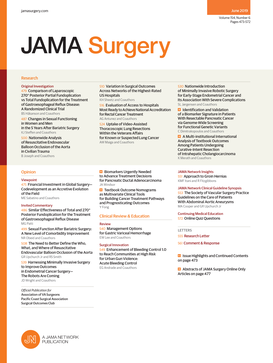Allocation Out of Sequence in Lung Transplant: An Analysis of the UNOS Registry.
IF 14.9
1区 医学
Q1 SURGERY
引用次数: 0
Abstract
Importance Allocation out of sequence (AOOS) allows organ procurement organizations (OPOs) to offer organs outside of standard allocation and bypass those atop the match run. AOOS may allow OPOs to successfully place medically complex organs; however, increasing use of AOOS also raises concern for inefficiencies within the allocation process and may exacerbate systemic inequities. Objective To characterize patterns of lung AOOS among organ procurement organizations and transplant centers and compare lung transplant characteristics and outcomes between in-sequence and AOOS groups. Design, Setting, and Participants In this retrospective cohort study, the United Network for Organ Sharing registry was queried for lung transplants performed between September 1, 2021, and June 30, 2024. Data were linked to the Potential Transplant Recipient file to identify all offers for included donor lungs. These data were analyzed from October 2024 to February 2025. Participants included adult donors who donated at least 1 lung for transplant and corresponding primary isolated lung transplant recipients. The final cohort included 7914 lung donor-recipient pairs. Exposure(s) Lung AOOS vs in sequence, defined by match-run refusal codes for donor lung offers. Main Outcome(s) and Measure(s) Donor and recipient characteristics, posttransplant outcomes, and OPO-level and transplant center-level rates of lung AOOS. Results Overall, 7914 lung transplants were included, of which 558 used AOOS (7.1%). Rates of lung AOOS ranged from 0% to 30% among OPOs and 0% to 50% among transplant centers. Use of lung AOOS increased in the continuous distribution era (10% vs 4%; P < .001). Donors of AOOS lungs were more likely to donate after circulatory death and had lower partial pressure of oxygen/fraction of inspired oxygen ratios, longer ischemic times, and longer travel distances. AOOS recipients were less likely to require pretransplant hospitalization, intensive care, and ventilator or extracorporeal membrane oxygenation support. On multivariable analysis, lung AOOS was associated with lower odds of prolonged intubation and early acute rejection and shorter posttransplant hospital length of stay. Conclusions AOOS is increasingly used in lung transplant and is associated with transplant of medically complex lungs into lower acuity recipients. Further investigation is needed to understand how AOOS affects lung utilization, especially in the era of continuous distribution.肺移植的分配顺序错误:美国器官捐献系统注册的分析。
顺序分配(AOOS)允许器官采购组织(opo)提供标准分配之外的器官,并绕过匹配运行之上的器官。AOOS可能允许opo成功放置医学上复杂的器官;然而,越来越多地使用AOOS也引起了对分配过程效率低下的担忧,并可能加剧系统性不公平。目的探讨器官采购机构和移植中心肺非器官oos的特点,比较顺序组和非器官oos组肺移植的特点和结果。设计、环境和参与者在这项回顾性队列研究中,研究人员查询了联合器官共享网络登记处在2021年9月1日至2024年6月30日期间进行的肺移植手术。数据与潜在移植受体文件相关联,以确定包括供体肺的所有报价。这些数据是从2024年10月到2025年2月进行分析的。参与者包括至少捐献1个肺用于移植的成年供者和相应的原发性分离肺移植受者。最终队列包括7914对肺供体-受体。暴露(s)肺AOOS与顺序,由供体肺提供的匹配运行拒绝代码定义。供体和受体特征、移植后结果、opo水平和移植中心水平肺AOOS发生率。结果共纳入7914例肺移植,其中558例采用AOOS,占7.1%。肺AOOS发生率在opo为0% - 30%,在移植中心为0% - 50%。连续分布时代肺部AOOS使用率增加(10% vs 4%;p < 0.001)。AOOS肺供者更可能在循环死亡后捐献,其氧分压/吸入氧分数比较低,缺血时间较长,旅行距离较长。AOOS受者不太可能需要移植前住院、重症监护和呼吸机或体外膜氧合支持。在多变量分析中,肺AOOS与较低的延长插管和早期急性排斥反应的几率以及较短的移植后住院时间相关。结论saoos在肺移植中的应用越来越广泛,并与医学上复杂的肺移植给低敏锐度受者有关。特别是在连续分布的时代,需要进一步研究AOOS对肺利用的影响。
本文章由计算机程序翻译,如有差异,请以英文原文为准。
求助全文
约1分钟内获得全文
求助全文
来源期刊

JAMA surgery
SURGERY-
CiteScore
20.80
自引率
3.60%
发文量
400
期刊介绍:
JAMA Surgery, an international peer-reviewed journal established in 1920, is the official publication of the Association of VA Surgeons, the Pacific Coast Surgical Association, and the Surgical Outcomes Club.It is a proud member of the JAMA Network, a consortium of peer-reviewed general medical and specialty publications.
 求助内容:
求助内容: 应助结果提醒方式:
应助结果提醒方式:


